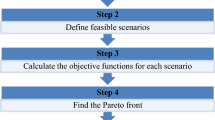Abstract
In communication networks, traffic carried over long paths suffers from a higher call blocking probability (CBP) than those carried over short paths. This is a well-known fairness problem. Such a problem becomes more serious in wavelength-routed optical networks (WRONs) due to the wavelength continuity constraint. This paper aims to enhance the fairness characteristic in WRONs by the novel classified alternate routing (CAR) approach. As a foundation of this approach, the first K-shortest paths (KSP) between a designated source/destination node pair in a given network should be obtained simultaneously. This has been studied as the KSP problem in the literature. In this paper, a new loopless deviation (LD) algorithm for solving such a loopless KSP problem will be proposed. It outperforms existing solutions in terms of running time in real-life implementations. In order to measure the fairness characteristic, we first classify all connection requests into categories such as 1-hop traffic, 2-hop traffic, etc., according to the number of minimal hop count between the corresponding source/destination node pair. We then quantify the fairness characteristic by the ratio of the average CBP of each traffic category to that of 1-hop traffic such that CBP ratios with a value closer to 1 are preferred. We will show that such a measure criterion is more precise and robust than existing ones in the literature. Finally, numerical experiments will reveal that the CAR approach outperforms existing fairness enhancement methods when considering the comprehensive performance in terms of the balance between the fairness characteristic and the overall CBP feature.
Similar content being viewed by others
References
Ramaswami R., Sivarajan K.N. (2002) Optical Networks: A Practical Perspective, 2nd edn. Morgan Kaufmann Publishers, San Francisco, CA, USA
Kaminow I.P., Doerr C.R., Dragone C., et al. (1996) A wideband all-optical WDM network. IEEE J. Selected Areas Commun. 14(5): 780–799
Chlamtac I., Ganz A., Karmi G. (1992) Lightpath communications: An approach to high Bandwidth optical WANs. IEEE Trans. Commun. 40(7): 1171–1182
Zang H., Jue J.P., Mukherjee B. (2000) A review of routing and wavelength assignment approaches for wavelength routed optical WDM networks. Opt. Networks Mag., SPIE 1(1): 47–60
Rouskas G.N. (2003) Routing and wavelength assignment in optical WDM networks. In: Proakis J.G. (eds).Wiley Encyclopedia of Telecommunications. John Wiley & Sons Inc, Hoboken NJ USA, pp 2097–2105
Zhu Y., Rouskas G.N., Perros H.G. (2000) A path decomposition algorithm for computing blocking probabilities in wavelength routing networks. IEEE/ACM Trans. Networking 8(6): 747–762
Jia Y., Nikolaidis I., Gburzynski P.(2001) Multiple path QoS routing. In: Proc. of ICC’01, pp. 2583–2587. Helsinki, Finland
Subramaniam S., Azizoglu M., Somani A. (1996) All-optical networks with sparse wavelength conversion. IEEE/ACM Trans. Networking 4(4): 544–557
Karasan E., Ayanoglu E. (1998) Effects of wavelength routing and selection algorithms on wave-length conversion gain in WDM optical networks. IEEE/ACM Trans. Networking 6(2): 186–196
Birman, A., Kershenbaum, A.: Routing and wavelength assignment methods in single-hop all-optical networks with blocking. In: Proc. of INFOCOM’95, IEEE, vol. 2, pp. 431–438. Boston, MA, USA (1995)
Li, Y., Francisco, M.J., Lambadaris, I., et al.: Traffic classification and service in wavelength routed all-optical networks. In: Proc. of ICC’03, IEEE, vol. 2, pp. 1375–1380. Anchorage, AL, USA (2003)
Harai, H., Murata, M., Miyahara, H.: Performance of alternate routing methods in all-optical switching networks. In: Proc. of INFOCOM ’97. IEEE, vol. 2, pp. 516–524. Kobe, Japan (1997)
Bisbal D., de Miguel I., Gonzále F., et al. (2004) Dynamic Routing and wavelength assignment in optical networks by means of genetic algorithms. Photon. Network Commun. 7(1): 43–58
Brander, A.W., Sinclair, M.C.: A comparative study of k-Shortest path algorithm. In: Proc. of 11th UK Performance Engineering Workshop, pp. 370–379 (1995)
Cheng, G., Ansari, N.: Finding all hops k-shortest paths, In: IEEE Pacific Rim Conference on Communications, Computers and Signal Processing 2003, PACRIM 2003, vol. 1, pp. 474–477 (2003)
de Azevedo, J.A., et al.: A shortest paths ranking algorithm. In: Proc. of the Annual Conference AIRO’90, Operational Research Society of Italy, pp. 1001–1011 (1990)
Hoffman W., Pavley R. (1959) A method for the solution of the Nth best path problem. J. Assoc. Comput. Machinery 6, 506–514
Yen J.Y. (1971) Finding the k-shortest loopless paths in a network. Manage. Sci. 17(1): 712–716
Topkis D.M. (1988) A k-shortest path algorithm for adaptive routing in communication networks. IEEE Trans. Commun. 36(7): 855–959
Lawler E.L. (1972) A procedure for computing the K best solutions to discrete optimization problems and its applications to the shortest path problem. Manage. Sci. 18(7): 401–405
Deryfus S.E. (1969) An appraisal of some shortest-path algorithm. Oper. Res. 17(3): 395–412
Cormen T.H., Leiserson C.E., Rivest R.L., et al. (2001) Introduction to Algorithms, 2nd edn. The MIT Press, Cambridge, MA, USA
Li J., Hanyi Z., Bingkun Z., et al. (2003) Performance evaluation of multi-granularity switching optical networks under dynamic traffic conditions. Acta Electron. Sinica 31(11): 1613–1617
Gerstel O., Ramaswami, R., Wang, W.K.: Making use of a two-stage multiplexing scheme in a WDM network. In: Proc. of OFC2000, IEEE, vol. 3, pp. 44–46, ThD1. Baltimore, MD (2000)
Author information
Authors and Affiliations
Corresponding author
Rights and permissions
About this article
Cite this article
Li, J., Zhang, H. A new solution to the K-shortest paths problem and its application in wavelength routed optical networks. Photon Netw Commun 12, 269–284 (2006). https://doi.org/10.1007/s11107-006-0027-0
Received:
Revised:
Accepted:
Published:
Issue Date:
DOI: https://doi.org/10.1007/s11107-006-0027-0




